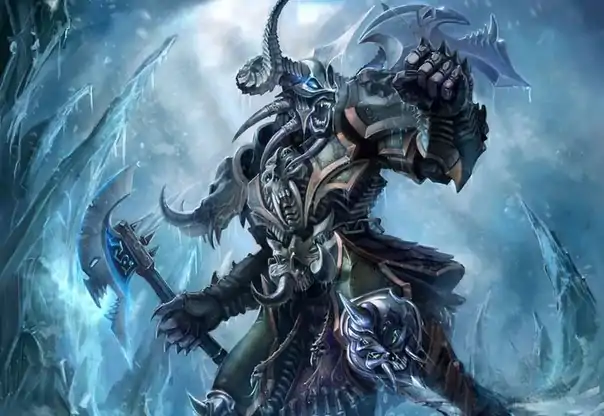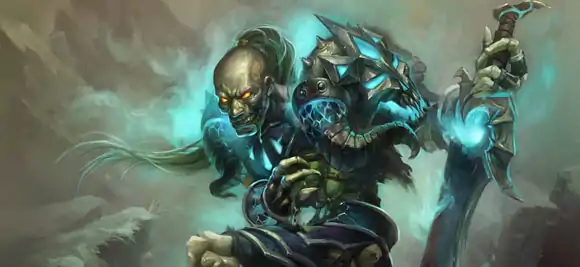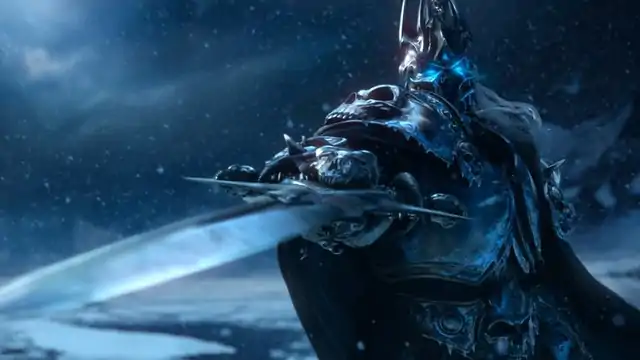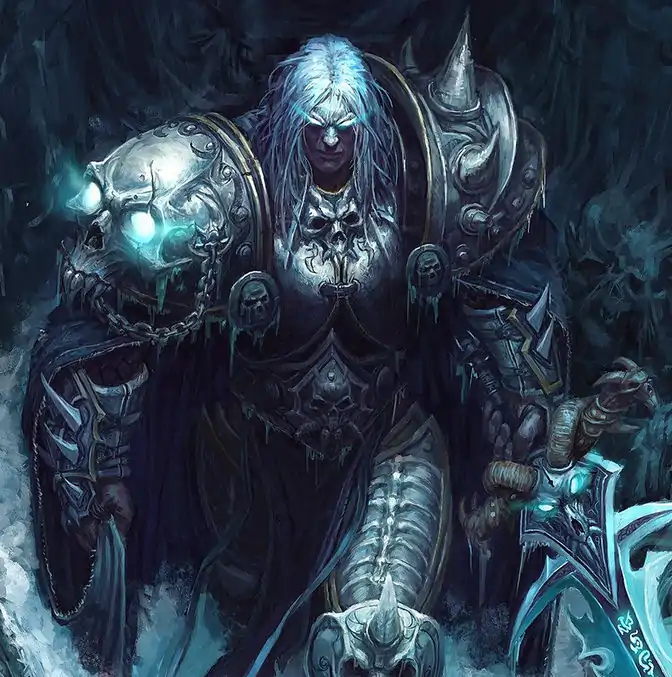Death Knight (4e Class)
Death Knight
 |
|---|
| “ | Risen from the dead, the death knights gain power from a pact they formed with dark forces, reborn as powerful Knights who are controllers of the undead. | ” |
| —JohnSmith82 | ||
| Class Traits |
| Role: Striker. A melee striker, they utilize minions and special effects to provide both damage and utility, and often weaken or hamper the target in some way. |
| Power Source: Divine. Despite being a dark and necrotic empowered class, they still gain power from divine inspiration. However, their inspiration is dark and unsettling, usually from evil or unaligned gods, willing to imbue their followers with power if they pledge allegiance to them. |
| Key Abilities: Strength, Charisma, Constitution |
| Armor Proficiencies: Cloth, leather, hide, chainmail, scale, plate; light shield, heavy shield |
| Weapon Proficiencies: Simple melee, military melee, simple ranged |
| Implements: Holy Symbol |
| Bonus to Defense: +1 Fortitude, +1 Will |
| Hit Points at 1st Level: 12 + Constitution score |
| Hit Points per Level Gained: 5 |
| Healing Surges per Day: 8 + Constitution modifier |
| Trained Skills: Religion. From the class skills list below, choose 4 more trained skills at 1st level. Class Skills: Acrobatics (Dex), Arcana (Int), Athletics (Str), Diplomacy (Cha), Endurance (Con), Heal (Wis), History (Int), Insight (Wis), Intimidate (Cha), Religion (Int) |
| Build Options: Pestilence, War, Death |
| Class Features: Summon Minion, Channel Divinity, Undead Body, Death's Embrace, Pestilence Pact, War Pact, Death Pact |
Death Knight Overview |
| Characteristics: The death knight is a predominately melee striker who augments his powers with unholy power, and utilizes minion attacks. While death knights mostly lack ranged powers, they can choose to strike at a distance with minions. |
| Religion: Death knights are divinely inspired, so their religion is extremely important to them. Despite being divinely inspired however, many death knights simply dedicate themselves to their gods as a way to gain power in return, meaning that their commitment to these Gods is quite often conditional. Death knights most often favor unaligned or evil gods, however a blend of variously aligned gods is not uncommon, with some choosing to worship both good and evil Gods. Many Good or Lawful Good death knights have forged a pact with Bane, the god of war, in order to receive his dark blessing, still being moral individuals who pay penance to their previous good aligned deities. Death knights who follow this route use their dark powers for good, rather than evil, but justify their often questionable actions and power source as a necessary for pragmatic reasons. As many death knights were previously paladins, it's not uncommon for them still to worship good or even lawfully good gods, and follow strict moral codes in other areas of life. |
| Races: The death knight favors races with Strength and either Charisma or Constitution, with Strength being the primary ability for all paths of the death knight. Dragonborn, goliaths, dwarves, muls, minotaurs, warforged and orcs strongly favor the class, while half-orcs and humans are known to make strong death knights, due to their extra utility and damage. Because their secondary abilities are not as important as strength, any race which boosts Strength can be ideal for the death knight. |
Creating a Death Knight
- Ability Scores
Strength should be your primary ability. As almost all of your powers utilize strength for the attack and damage roll, strength should have the highest score of all your abilities, and 20 or 18 strength at character creation (after racial bonuses are added) is recommended. Secondary abilities, such as Charisma or Constitution, are also useful for the death knight. Charisma will help boost abilities in the Pestilence Pact, or with powers that possess special abilities, where as Constitution helps to boost the War Pact, which rests primarily on doing extra damage. The Death Pact benefits primarily from strength, and can benefit from either constitution or charisma powers depending on your choice of powers.
- Feats
Death knights are as much about toughness and utility as they are about doing extra damage. Therefore, a blend of defensive and offensive feats is recommended, although your naturally high defenses may not necessitate such feats. Toughness and improved defenses are good, but like for any melee striker, an emphasis on weapon's and expertise feats are suggested. Any weapon proficiency or similar feat is thus suggested, as well as weapon focus. With an emphasis on cold and necrotic damage, Burning Blizzard or Dark Fury are recommended. Newer death knight feats are also recommended, which allow you to replace abilities like Dark Fury or Burning Blizzard, and augment your other powers.
- Equipment
As you are a class dependent on heavy armor, with secondary abilities that do not boost lightly armored defenses (such as Dexterity or Intelligence), you should start with the highest armor you can, or plate. Scale is a possible option, however you will lose some defenses for added maneuverability. Choosing heavy shields or two-handed weapons will be your biggest choice; if you want to do more damage, you should go with two-handed weapons, which also can receive additional benefits with certain powers based on your pact and secondary attributes (adding constitution as extra damage on some attacks). As all of your melee attacks can substitute your enhancement with your implement bonus instead, and your minion attacks will be dependent on your implement bonus, it is wise to choose a magical holy symbol. Otherwise, standard adventuring gear is suggested.
- Implement Bonus
When you wear or hold your holy symbol, you can add its enhancement bonus to the attack rolls and the damage rolls of powers that have the implement keyword. You can also add its enhancement bonus to the attack rolls and the damage rolls of weapon attacks you make using a weapon with which you have proficiency.
You can also use a weapon as an implement if you are proficient with that weapon. When wielding the weapon as an implement, the weapon's characteristics-proficiency bonus, damage die, and weapon properties like defensive or high crit-are irrelevant to your implement powers. Only the weapon's enhancement bonus applies to implement rolls.
If you have both an implement and a magic weapon, you choose before you use an attack power whether to draw on the magic of the implement or the weapon. Your choice determines which enhancement bonus, critical hit effects, and magic item properties and powers you can apply to that power. You can't, for example, use the enhancement bonus of implement and the critical hit effect of your magic weapon with the same attack.
Undead Body
Members of this class are considered undead creatures for the purpose of effects that relate to the undead keyword. You are also considered a living creature. You do not need to eat, drink, breathe or sleep. You never have to make Endurance checks to resist the effects of starvation, thirst, or suffocation.
Summon Minion
Death Knight Minion's (4e Creature)
You can summon a minion under your control, a number of times per day, equal to your Minion Threshold limit. An ordinary minion lasts until the end of the day or until it is killed. The minion can attack separately from you, and can make move, minor, and standard actions as if it were another character or creature. As it is a minion of yours, it cannot speak to most creatures and does not have the common language, although it can speak to other undead and death knights. You can communicate with your minion telepathically out to a range of 20 squares. The minion's attributes, capabilities, and damage are all determined by the minion of your choice. When minions die, they disappear for the rest of the day, but can be re-summoned the next day. Minions never truly die, as they simply return to the netherworld to heal, or can be reanimated. You gain a minion threshold, which limits how many minions you can summon or resummon per day, which at heroic tier is 2 minions per day. At level 11, you can summon a minion 3 times per day, and at level 21, you can summon a minion 4 times per day. You still cannot have more than one minion summoned at a time, unless a power otherwise specifies. Certain powers (especially dailies), allow you to summon additional minions. However, you can only summon these additional minions a number of times equal to your daily value. So, for instance, if you summoned a ghoul minion one time in a day, you could only summon one daily minion for that day (although you could still use that daily power, just not summon the minion). Summoning daily minions often dismiss your primary minion, but this minion can be resummoned without counting towards your daily value (unless otherwise stated).
A list of death knight minions can be found in the Death Knight Minion's (4e Creature) page. Death knight minions are an important part of the death knight's damage, just like the ranger's Hunter's Quarry or Warlock's Curse. For all intents and purposes, they count as another creature, and thus provide flanking benefits for combat advantage. They are not capable of opportunity attacks, however (unless a power otherwise specifies). In addition to this, they provide extra damage, ranging from 1d4 to 1d10 as extra damage to the target, more or less replicating abilities like Hunter's Quarry or Warlock's Curse of similar striker classes. They also allow multiple targets to be targeted, giving them the ability to pick off multiple enemies at once. Death knight minions are an extension of the death knight themselves; any creature they kill or do damage to count as the death knight, and their attributes are based on the death knight's own. Further, they use the death knight's strength to determine their own attack and damage rolls, as well use a fraction of the death knight's health. Their defenses and skill bonuses also improve by the death knight's, or 1/2 the death knight's level. Any armor enhancement bonuses you receive from your equipment are also added to the minion's defense bonuses. Minions gain your implement enhancement bonus to attack rolls; as your weapon can serve as an implement, this bonus can be the equivalent of your weapon. They do not however gain any special effects from your weapon or implement when attacking, just the enhancement bonus to attack rolls.
If you choose the ghoul minion, you can summon two at a time at no extra cost or limit to your daily summoning value. However, all other minions can only be summoned once at a time (unless otherwise specified). Certain powers allow you to summon extra minions, and these powers are considered separate from the Summon Minion power. So for instance, if the War Pact allowed you to summon an extra ghoul to damage, it would not count towards your daily summoning limit, or count as an ordinary Summon Ghoul ability. Thus, you can use two ghouls, instead of one (capable of striking 3 targets instead of 2, and using 2d4 total damage).
Minion Threshhold
You can only summon a number of minions per day, equal to your minion threshold. This starts off at 2 at level 1, and increases to 3 at level 11, and 4 at level 21. Whether special minions or ordinary minions, you can only summon so many minions per day. Unless a power otherwise specifies, summoning any kind of minion counts towards your daily threshold. In particular, daily powers generally allow you to summon a creature for only 2 turns before it counts towards your daily minion threshold. After 2 turns, the creature counts towards your daily minion threshold and thus the total number you can summon. Thus, you can only summon your primarily minion and a special minion with your daily power once per day. If you primary minion dies, you must resummon it, and thus this counts towards your daily minion threshold. If you switch minions and summon another minion in it's place, this also counts towards your daily minion threshold. This prevents you from using too many daily powers or summoning too many different types of minions per day. It also prevents you from resummoning your minion an infinite amount of times per day, should it die. As it is an essential part of your damage, you don't want to lose the ability to summon your minions. Ghouls notably don't count towards your daily minion threshold like normal minions do. You can summon an extra ghoul with no impact on your daily minion threshold.
Death's Embrace
You gain an extra attack power, based on either Charisma or Constitution. You can use the power once per day equal to your highest ability modifier of Charisma or Constitution. So, if you had 16 Charisma, you could use the power 3 times per day. You deal extra damage to the target equal to half your healing surge value plus your strength modifier as extra damage, at the cost of one healing surge, which cannot be reduced in any way.
Channel Divinity
Once per encounter you can invoke divine power, filling yourself with the might of your patron deity. With the divine might you invoke you can wield special powers, such as Patron Mettle and Unholy Strength. Some death knights learn other uses for this feature; for instance, the divinity feats in Chapter 6 (PHB1) grant characters with access to the Channel Divinity class feature the ability to use additional special powers.
Regardless of how many different uses for Channel Divinity you know, you can use only one such ability per encounter. The special ability or power you invoke works just like your other powers.
Knight Pact
As a death knight, you have the choice of three pacts, the Pestilence Pact, the War Pact, and the Death Pact. As the unholy knights of death, you gain features of the Horsemen of the Apocalypse. With each pact, you gain the following bonuses:
Pestilence Pact:
The pestilence pact favors Strength and Charisma as it's primary and secondary abilities. In addition, any target suffering from an ongoing condition you've inflicted takes a -2 penalty to saving throws against them. Certain powers receive bonus's when you use the Pestilence Pact. In addition, you gain the encounter power "The Plague." When a non-minion creature you've attacked in the last turn dies, you can choose for any creature moving through it's space to contract "The Plague", which deals damage over time equal to your Charisma modifier (save ends).
War Pact: The war pact favors Strength and Constitution as it's primary and secondary abilities. With certain powers, you may add your constitution modifier as extra damage to the target. In addition, you gain the "Rising Fury" encounter power. When a non-minion creature you've attacked dies from that attack, you can choose for it to be reanimated as a ghoul, until the end of the encounter.
Death Pact The Death Pact pact favors Strength and either Constitution or Charisma as it's primary and secondary abilities. When you have the Death Pact, you may use a one-handed weapon in your off-hand as if it is an off-handed weapon. In addition, you gain the two-weapon defense feat even if you don't meet the prerequisites. You also gain the "Shadow Burst" encounter power. When a non-minion creature you've attacked in the last turn dies, a cloud of shadow forms in a 5 x 5 zone in the creature's space, which grants all creatures within it partial concealment (which you can ignore). While in the cloud of shadow, you can take a free reaction to gain concealment, and the concealment can persist with a sustain minor.
If you chose the Pestilence pact, you gain the power "The Plague."
If you chose the War Pact, you gain the "Rising Fury", power.
If you chose the Death pact, you gain the power "Shadow Burst."
Heroic Death Knight
| Level | Feats Known | Class Features and Powers |
|---|---|---|
| 1 | 1 | Undead Body
Summon Minion Death's Embrace Channel Divinity Knight Pact |
| 2 | +1 | Utility Power |
| 3 | 1 Encounter Power | |
| 4 | +1 | Ability Score Increase |
| 5 | 1 Daily Power | |
| 6 | +1 | Utility Power |
| 7 | 1 Encounter Power | |
| 8 | +1 | Ability Score Increase |
| 9 | 1 Daily Power | |
| 10 | +1 | Utility Power |
Level 1: At-Will Powers
Benefit: You gain two of the following powers. At level 21, the damage of the at-wills increases to double the damage die or 2[W].
Level 1:
Benefit: You gain one of the following encounter powers, and gain one of the following daily powers:
Level 2: Utility Power
Benefit: You gain one of the following powers.
Level 3:
Benefit: You gain one of the following powers.
*Note: This power can only be used with regular minions, and not special minions.
Level 4: Ability Score Increase
Your constant training hones your body and mind.
Benefit: You increase two ability scores of your choice by 1.
Level 5:
Benefit: You gain one of the following powers.
Level 6: Utility Power
Benefit: You gain one of the following powers.
Level 7:
Benefit: You gain one of the following powers.
Level 8: Ability Score Increase
You reap the reward of constant challenge by increasing your physical and mental well-being.
Benefit: You increase two ability scores of your choice by 1.
Level 9:
Benefit: You gain one of the following powers.
Level 10: Utility Power
Benefit: You gain one of the following powers.
Paragon Death Knight
 |
|---|
| Level | Feats Known | Class Features and Powers |
|---|---|---|
| 11 | +1 | Ability score increase Paragon Path Features Paragon Path Power |
| 12 | +1 | Paragon Path Power |
| 13 | 1 Encounter Power | |
| 14 | +1 | Ability score increase |
| 15 | 1 Daily Power | |
| 16 | +1 | Paragon Path Feature |
| 17 | 1 Encounter Power | |
| 18 | +1 | Ability score increase |
| 19 | 1 Daily Power | |
| 20 | +1 | Paragon Path Power |
Level 11: Ability Score Increase
Your improved physical and mental prowess highlights your entrance into the paragon tier.
Benefit: Each of your ability scores increases by 1.
Level 11: Paragon Path Features
Benefit: You gain the level 11 features of your chosen paragon path. The suggested Paragon Path is the "Unholy Knight", path.
Knight's Action (Level 11): When you spend an action point to make an attack, the target of the attack also takes a -2 penalty to all defenses (save ends).
Necrotic Skill (Level 11): You gain a +1 bonus to attack rolls of weapon attacks.
Knight's Ascension (Level 16): You are immune to all diseases, and you never have to make Endurance checks to resist disease or fatigue. You are also immortal, and considered an immortal creature for the purpose of effects that relate to creature origin. Whenever you drop to 0 hit points or fewer, you are dying but you can choose to remain conscious until you fail your first saving throw. You also gain a +2 bonus to all saving throws.
Level 11: Paragon Path Power
Benefit: You gain the level 11 power of your chosen paragon path.
Level 12: Paragon Path Power
Benefit: You gain the level 12 power of your chosen paragon path.
| Death's Defiance | Death Knight 4e Power Type::Utility 12 |
| Your very essence defies the presence of death, resisting it at every turn. | |
| 4e Power Usage::Daily | |
| 4e Power Action Type::Free Action | Personal |
| Trigger: You drop at or below zero hitpoints. | |
| Target: Yourself. | |
| Effect: You are no longer dying and can spend two healing surges to regain hitpoints equal to your bloodied value. | |
Level 13:
Benefit: You gain one of the following powers.
*Note: This power can only be used with regular minions, and not special minions.
Level 14: Ability Score Increase
Each new challenge only makes you stronger in body and mind.
Benefit: You increase two ability scores of your choice by 1.
Level 15:
Benefit: You gain one of the following powers.
Level 16:
Benefit: You gain one of the following powers.
Level 17:
Benefit: You gain one of the following powers.
Level 18: Ability Score Increase
You are a true paragon of physical and mental perfection.
Benefit: You increase two ability scores of your choice by 1.
Level 19:
Benefit: You gain one of the following powers.
Level 20: Paragon Path Power
Benefit: You gain the level 20 power of your chosen paragon path.
Epic Death Knight
 |
|---|
| Level | Feats Known | Class Features and Powers |
|---|---|---|
| 21 | +1 | Ability score increase Epic Destiny Feature |
| 22 | +1 | |
| 23 | 1 Encounter Power | |
| 24 | +1 | Ability score increase Epic Destiny Feature |
| 25 | 1 Daily Power | |
| 26 | +1 | Epic Destiny Power |
| 27 | 1 Encounter Power | |
| 28 | +1 | Ability score increase |
| 29 | 1 Daily Power | |
| 30 | +1 | Epic Destiny Feature |
Level 21: Ability Score Increase
You are an epic hero now, and your physical and mental acuity exceed all mortal limits.
Benefit: Each of your ability scores increases by 1.
Level 21: Epic Destiny Feature
Benefit: You gain the level 21 feature of your chosen epic destiny.
Level 22:
Benefit: You gain one of the following powers.
Level 23:
Benefit: You gain one of the following powers.
Level 24: Ability Score Increase
The threats of the epic challenges you face are countered by the perfection of your body and mind.
Benefit: You increase two ability scores of your choice by 1.
Level 24: Epic Destiny Feature
Benefit: You gain the level 24 feature of your chosen epic destiny.
Level 25:
Benefit: You gain one of the following powers.
Level 26: Epic Destiny Power
Benefit: You gain the level 26 power of your chosen epic destiny.
Level 27:
Benefit: You gain one of the following powers.
Level 28: Ability Score Increase
 |
|---|
Training, practice, and experience have molded your abilities. Even as you near your final destiny, you continue to hone your talents for the tests you will soon face.
Benefit: You increase two ability scores of your choice by 1.
Level 29:
Benefit: You gain one of the following powers.
Level 30: Epic Destiny Feature
Back to Main Page → 4e Homebrew → Classes, Paragon Paths, and Epic Destinies → Classes